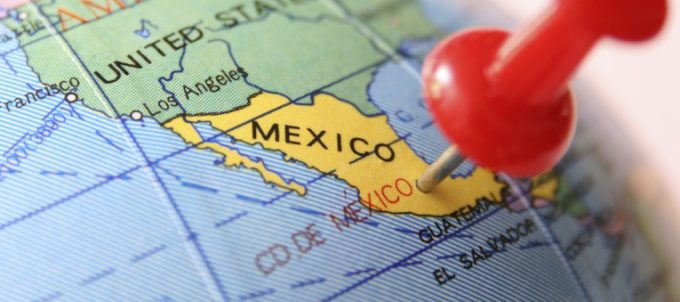Mexican president to launch major expansion at constricted Manzanillo
Mexico’s top container gateway is going to get a lot bigger: on Saturday Mexican president ...
UPS: MULTI-MILLION PENALTY FOR UNFAIR EARNINGS DISCLOSUREWTC: PUNISHEDVW: UNDER PRESSUREKNIN: APAC LEADERSHIP WATCHZIM: TAKING PROFITPEP: MINOR HOLDINGS CONSOLIDATIONDHL: GREEN DEALBA: WIND OF CHANGEMAERSK: BULLISH CALLXPO: HEDGE FUNDS ENGINEF: CHOPPING BOARDWTC: NEW RECORDZIM: BALANCE SHEET IN CHECKZIM: SURGING
UPS: MULTI-MILLION PENALTY FOR UNFAIR EARNINGS DISCLOSUREWTC: PUNISHEDVW: UNDER PRESSUREKNIN: APAC LEADERSHIP WATCHZIM: TAKING PROFITPEP: MINOR HOLDINGS CONSOLIDATIONDHL: GREEN DEALBA: WIND OF CHANGEMAERSK: BULLISH CALLXPO: HEDGE FUNDS ENGINEF: CHOPPING BOARDWTC: NEW RECORDZIM: BALANCE SHEET IN CHECKZIM: SURGING

Mexico has been one of the main beneficiaries of the near-shoring trend, but lack of investment and strategic planning is hobbling its potential to support and expand, industry groups warn.
According to the Mexican Chamber of the Construction Industry (CMIC), these shortcomings are already a serious drag on the economy.
“Logistical and transportation deficiencies cost Mexico about 169.3bn pesos ($8.82bn) in 2023,” said CMIC national president Luis Mendez.
And he warned that significant investment in transport and logistics infrastructure was needed.
CMIC wants to see public spending to rise to 5%, or 6%, of GDP, with a significant portion going to logistics and transport infrastructure – modernisation of roads, railways, ports and airports, as well as sustainable urban mobility systems.
Besides security, inadequate infrastructure is widely seen as a second major problem for foreign investors and companies looking to set up production in Mexico.
CMIC wants the incoming administration to prioritise infrastructure projects that enhance global value chains and stimulate regional economic activities by improving key transport and logistics hubs. It calls for a push on multimodal logistics connectivity projects that help remove bottlenecks for final-mile services.
A frequent complaint has been the mismatch of public and private spending on logistics projects. Private firms have invested in facility developments like container terminal expansion and modernisation, but such moves have not been matched by public investment in the improvement and development of road infrastructure and industrial parks.
Public agencies have to align better with industry to develop strategic planning, industry groups say. The Mexican Association of Port, Maritime and Coastal Infrastructure recently called on the National Port System Administration (Asipona) to work on a strategic development plan for infrastructure in consensus with industry and market needs.
A recent calamity that has reinforced calls for a more strategic approach played out on 31 July and 1 August, when road access to the port of Manzanillo was blocked, which left some 5,000 trucks and other vehicles stranded for up to 24 hours.
There have been conflicting accounts of how the traffic freeze unfolded. According to some reports, a failure in customs systems at the port paralysed the inflow of trucks, resulting in a cascading traffic jam that engulfed highways to the port. Other sources claim computer systems were running normally and blamed Asipona Manzanillo, alleging it had leased a 170-acre holding yard, where trucks previously parked before entering the port, to private interests. Either way, road access to the port was clogged up, leaving terminals empty. Their plight was aggravated by the derailment of a train headed for the port that impeded rail access the following days.
Communidad Portuaria de Manzanillo, the port’s user group, highlighted several problems that affect the circulation of trucks at the port and called for collaboration from external yards, to expedite truck movements and keep roads free, and from truckers, to follow instructions from road agents.
Others have pointed out that congestion is not a novel experience on highways to the port. Trucking activity at the port rose 9% year on year in the first half of this year. The port sees more than 4,000 truck calls a day.
Being Mexico’s largest Pacific gateway, Manzanillo clocked up 4% growth in throughput in the first quarter, with box traffic up 11.5%, to 935,710 teu.
Investment inside the port is moving forward. Terminal operator Contecon unveiled two 60-metre ship-to-shore cranes in May, supposedly the tallest deployed in North America. Complemented by five rubber-tyred gantry cranes, they are part of a $300m outlay to raise the terminal’s capacity to more than two million teu.
Operators hope the incoming government will embrace a more strategic growth strategy to improve transport infrastructure. CMIC has put together a “strategic project bank” outlining what it sees as necessary steps to support the nearshoring momentum.
Comment on this article